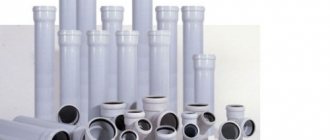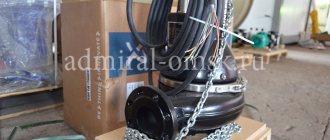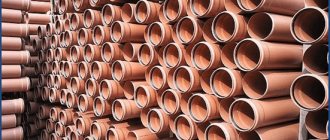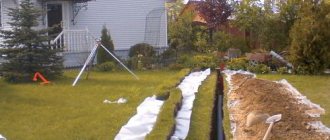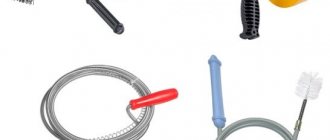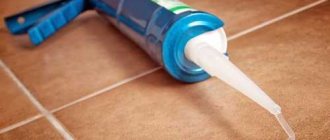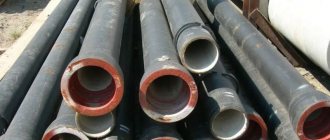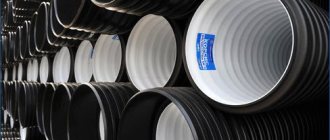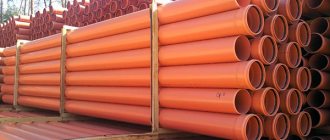The technology for designing and assembling sewer lines is constantly striving to achieve a higher level of improvement through the use of new materials of superior quality. The advent of high-quality PVC sewer pipes with a wide range of components today has made it possible, without much labor and expense, to quickly assemble a high-quality sewer system that will last for decades. It is known that the effective operation of a wastewater disposal system is based on the laws of physics, so design and installation bear the main responsibility. Here, various connection elements have been created to help us - fittings for PVC sewer pipelines (fittings).
Using the types of fittings available on the market, connecting sewer pipes can be done easily and simply
Purpose
Sewage fittings are among the main parts of drainage systems. They are no less important than pipes or other components, since they are involved in the transportation of wastewater. In addition, fittings perform dispatch functions. They form a network and make its work possible. During reconstruction or repair, using fittings, new sections are connected and connected to other lines.
Shaped products, or fittings (sometimes also called additional elements) are used to change the configuration of the drainage network. They are installed at different points in the system:
- rotation of pipelines in a horizontal plane;
- change in channel cross-section;
- branching or connecting an additional line;
- installation of service elements;
- connecting dissimilar parts of the system;
- connecting plumbing fixtures;
- connection to containers or collectors.
Using certain types of fittings, you can assemble a sewer network of any size, length and configuration. In addition, you can change an existing line, add additional bends or devices to it. Shaped sewer parts can be installed at any point in the system if required by the assembly drawing or if the need arises during operation of the network. The possibilities of fittings are very large. It can be said with good reason that the configuration of the system is determined by the fittings, and the pipelines only connect them to each other.
Advantages of plastic fittings for sewerage
To the advantages of plastic sewer fittings already mentioned above, it is worth adding:
- no influence on the transported medium - they do not oxidize, do not support the proliferation of bacteriological films, do not color or thicken wastewater;
- no impact on throughput - stable smoothness of the wall and constant clearance ensure the efficient functioning of sewer networks;
- reduction in installation costs - ready-made joints with O-rings do not require expensive welding;
- no impact on the environment - do not emit toxins, do not decompose in the ground;
- long life cycle - at least 50 years under manufacturer's warranty.
Installation is carried out using glue or silicone sealant. The connections are conditionally detachable. A chisel and solvent are required for dismantling. If the joint cannot be disassembled, the shaped part is cut off completely and a new section is installed.
When choosing, pay attention to the markings, select the correct type and operating temperature.
Types of shaped products
The shaped sewerage elements fully correspond to the pipelines in size, material and other parameters. This is important because the system transports wastewater at different temperatures. If elements from different materials are used during assembly, the amount of thermal expansion will be different. This will negatively affect the connections and cause leaks.
There are different types of fittings. According to their purpose, they are divided into internal and external. The first (gray) are used when assembling sewage systems inside buildings, and the second (red) work with external sections of the network. In addition, there are pressure and non-pressure elements. As a rule, systems are gravity flow, so non-pressure parts predominate.
The materials for the manufacture of shaped products are:
- PVC;
- polypropylene;
- cast iron.
The first two materials are the main ones today, and cast iron elements are used only in industrial or storm water networks. This is caused by the different complexity or speed of assembly of cast iron and plastic parts. Polypropylene elements are more often used for external networks because they withstand low temperatures better. PVC products are found everywhere, but their main area of application is pipes for internal sewerage and fittings.
There are fittings designed to perform various functions and tasks.
- through-type, compensating or thrust couplings. They are used to connect straight sections of socketless pipes, and are also used when inserting additional elements into an already existing system;
- bends. Designed to change the direction of a line. There are bends with different angles of rotation - 15°, 30°, 45°, 67°, 90°;
- tees. Used to connect plumbing fixtures or create a branch from the main line. There are tees with outlets at right angles or 45° (straight and oblique tees);
- reduction. It is used when different inlet and outlet sizes of sewerage fittings made of PVC or propylene are required;
- crosspieces are one- and two-plane. They are used in key areas of the system, on risers. There are crosses with bends at 90° or 45°. The diameter of the bends can be the same as that of the straight section (usually 110 mm), or less;
- transitions. These are elements that allow you to connect pipes of different diameters. As a rule, the axes of the pipelines do not coincide. This is done so that both parts can be conveniently attached to the supporting plane with clamps;
- revision. This is a type of tee, the central part of which is equipped with a sealed lid. Used for cleaning pipelines;
- check valve Prevents the movement of waste in the opposite direction;
- stub. Installed at the free end of the pipe to seal the system.
Connection type
In addition, the shaped parts of PVC sewer pipes, the dimensions of which correspond to the diameter of the pipelines, differ in the type of connection. Exist:
- socketless elements;
- socket for sealant;
- bell-shaped for a rubber ring.
The last group of fittings is the most popular. It is characterized by high assembly speed and does not require any special tools for installation. The pipes are simply inserted into the socket, where they are tightly sealed with a rubber sealing ring. When assembling, do not immerse the free end into the entire length of the connecting element. It is necessary to make a small power reserve for thermal expansion of the material.
All fittings of sewer pipes are made of the same material as the pipelines. All varieties have their own set of fittings - PVC, propylene or cast iron pipes. It is not recommended to use connecting elements from different types of sewer systems. They will either not fit in size, or will have different physical properties. You need to immediately purchase the necessary parts.
Also read: Moving a sewer system to another room: ways to move a kitchen or riser to a living room
What are tees and features of their use
Tees for plastic pipes can be called one of the most necessary elements in the process of organizing a pipeline.
Such an element is a universal part that can be used on both reinforced and non-reinforced pipelines. They are also necessary for branching the pipeline, with the pipes diverging at an angle of 900.
Tees should be used to connect pipes at different angles
Tees can have different installation methods and this must be taken into account:
Some versions of tees are attached to pipes using adhesive, others using a threaded connection. With the right approach, any type of connection will be reliable and sealed.
Adhesive connection
They also have a certain classification, which must be taken into account when planning the purchase of such items. When purchasing, you need to focus on the type and features of the pipeline.
So, the following types of tees for plastic pipes are distinguished:
- transitional;
- combined, having an internal thread;
- combined, having an external thread;
- with union nut.
Tee for PVC pipes and determining its dimensions
Dimensions of tees degrees depending on the size of the pipe
You need to choose a specific type of tee responsibly, since the reliability of the future pipeline depends on the correct choice. But in the process of organizing a sewer system, attention must be paid not only to the connecting elements, but also to other protective elements, for example, a fire protection coupling.
Advantages
The advantages of plastic shaped parts are considered to be:
- a wide range of;
- relatively low price;
- durability;
- low noise level;
- light weight, facilitating transportation and installation;
- smooth external and internal surfaces, reducing the risk of blockages;
- corrosion resistance;
- mechanical strength;
- ability to work with aggressive wastewater;
- ease of installation.
Thanks to these qualities, fittings allow you to create durable drainage systems.
Types of fittings
- Couplings for connecting pipes. Using them, you can connect several sections of pipes into a single pipeline. Typically used for the construction of straight sections of pipes of the same section.
- Repair coupling . This shaped element is a kind of “patch” that is placed on top of a damaged plastic pipe, preventing leaks.
- Compensation pipe . The damaged section of the pipeline is cut out and, using a socket and coupling, a compensation pipe replaces the damaged section.
- Retraction . This shaped element is used to change the direction of fluid flow through sewer pipelines. Bends are available with different rotation angles, for example, 45 or 90 degrees.
Sewer tee
- Sewer tee . Designed to form “T-shaped intersections” in the sewer network.
- Crosspiece . This shaped part forms a regular intersection. Since the movement of liquid in the sewer pipeline is one-way, several sewer flows are merged into one using tees and crosses. Various “roads” at such intersections can adjoin the main one not only at a right angle, but also at an acute or obtuse angle, and even connect in different planes.
- Sewer plug . It is used in the formation of temporarily unused sections of sewer pipelines so that unpleasant odors from sewage do not penetrate into the home. It is a quick-detachable element.
- Aerator or sewer valve . Prevents changes in the direction of liquid flow in sewer pipes and prevents the penetration of unpleasant odors into the home from sewers. Like sewer pipes, aerators can have different cross-sections.
- Clamps . Used to fix sewer pipes to walls, floors, or any other fixed support. Usually made of plastic, they are quite convenient to use, are not subject to corrosion and securely fasten pipelines. When using clamps, it is recommended to place soft rubber gaskets between them and the pipes. In addition to preventing damage to pipes, rubber will also reduce noise levels when sewage flows through.
Fitting option
- Shaped element “revision” . It is intended to facilitate access to the internal space of pipelines during emergency repair or maintenance work. Has a quick-release cover with a threaded or screw connection.
- Adapters or reductions . This shaped element is designed to connect two other sections having different internal sections. Typically used for repairs.
- Fireproof sleeve for sewer pipes. This shaped element is a protective shell and is installed in places where the sewer system passes through ceilings or walls. Its purpose is to block the path of fire in the event of a fire in one of the premises. The fitting is a ring made of steel, inside of which there is a material that significantly expands its volume when heated.
- In addition, there are other highly specialized shaped elements. Thus, a drain for collecting water is used when arranging shower cabins, and an “umbrella” ensures increased air circulation in the sewer drain pipe.
Dimensions
The dimensions of the PVC sewer fittings, the drawings of which are made when drawing up the project, correspond to the throughput of the system. There is a full range of shaped products for all diameters of plastic pipelines (PVC, propylene or polyethylene). In addition, fittings allow you to combine pipe lines with different diameters. The most commonly used elements are 110 mm and 50 mm. In the same way, the dimensions of polypropylene fittings for internal sewerage are selected. for external areas, as a rule, larger parts are used - 160 or 200 mm. They have increased capacity and are capable of transporting a large volume of wastewater from a variety of plumbing fixtures. All types of fittings are available for sale in all sizes, although the smallest or largest elements are rarely used.
What is a fire coupling, its features
Fireproof couplings for sewerage can be called a mandatory element for those who value their safety. This is an extremely useful and, one might even say, necessary device, as it ensures the safety of the room and all its occupants.
This is what a fire coupling looks like installed on a riser
This element is considered especially indispensable in multi-storey residential and office buildings. By installing a fire-prevention coupling on the sewer, in the event of a fire, you can prevent the rapid spread of fire.
Despite its importance, such an element has a fairly simple design, since a coupling of this type consists of a body and a liner. The body of such an element is made of durable metal and has the shape of a cylinder.
Main elements of a fire protection coupling
As for the liner, it is made of a special fire-retardant material, which in the event of a fire provides a plug effect, blocking the spread of fire through the pipeline. But here it is very important that the coupling has the exact size and is tightly attached to the pipeline.
In order for a fire protection coupling to be truly effective, it is very important that such elements are installed on all plastic pipes in the house. This element must be attached to the wall or ceiling.
Installing a fire protection coupling on a sewer riser
Installation of a fireproof coupling is quite quick and simple; it can be performed not only at the stage of pipeline organization, but also at the stage of its operation.
Photo: fireproof coupling for sewer riser
As already mentioned, a fireproof coupling is especially necessary for sewerage in multi-storey buildings.
But it can be installed not only on sewer pipes, but also on other plastic pipelines, for example, water pipes.
Such elements can significantly increase the reliability of plastic pipes, which, of course, indicates the benefit not only of the couplings themselves, but also increases the safety of plastic pipelines.
Sewage couplings of this type can be installed in absolutely any premises.
This coupling can be installed both in the house and in the apartment
If a person wants to increase the reliability and safety of his country house or cottage, then he can install fireproof couplings on all plastic pipelines in the house.
The popularity of such elements is increasing significantly every day and this is not surprising, because any person is very responsible for his safety and the safety of his home.
It is important to note that this element is produced in accordance with the dimensions of existing pipes.
Dimensions of PHOENIX fireproof couplings for sewer pipes
That is, such couplings come in different diameters, so choosing an element for a specific pipeline will not be difficult. Thanks to the variety of diameters, it is possible to ensure good tightness when installing the coupling on a pipeline.
Previous articles Next articles
Related Posts
- 25.06.2016.
Sewer pipes from Politek: choose yourself
- 23.06.2016.
Polytron sewer pipes: features, price, installation
- 14.05.2016.
Elements of external sewerage
In addition to the pipes themselves, revisions and bends, the outer section of the drainage system also includes several specific elements. In the case of an autonomous sewer system, wastewater needs to be stored somewhere while it is being cleaned, so you will need to build a septic tank, or better yet, a septic tank.
Construction of a settling tank
Sewage settling tanks are a regular pit in which wastewater settles, large particles settle to the bottom, after which the clarified wastewater moves to the next stage of treatment. Externally, the sump looks like a pit with reinforced walls and bottom (or a special container).
If the sump is built independently, then the instructions look like this:
- a hole is dug in the ground (depth approximately 2.5 m, cross-section at least 2.0x2.0);
- a cushion of a layer of gravel is poured onto the bottom of the pit, on top of which a sand layer is placed;
- after this you need to seal the bottom and walls of the pit. You can build formwork, place a reinforcement frame in the pit and fill the walls and bottom of the pit with concrete mixture; you can reinforce the walls with brickwork;
The walls of the sump are lined with bricks
- when the concrete hardens, all that remains is to concrete the ceiling and arrange ventilation for the sump.
In the photo - a concrete sump
You can go the other way; instead of labor-intensive concreting, many use large-volume plastic containers for sedimentation tanks. These can be Eurocubes, plastic barrels, metal barrels in which paint and varnish materials were previously stored. The price of installing a sump in this case is low, but tightness is ensured.
There are also budget options for settling tanks. From ordinary truck tires, you can build a septic tank suitable for irregularly used sewage systems.
A simple tire sump
Septic tanks stand apart. Externally, such a container looks like a large barrel with ventilation pipes, and the internal space is divided into separate zones: first, the wastewater settles, then through the overflow system the liquid enters the second section, where final cleaning occurs.
Septic tank operation diagram
Note! If paintwork materials were previously stored in a barrel, then it can be used as a settling tank only after thorough cleaning and firing. Otherwise, there is a risk of soil contamination with chemicals.
Fluoroplastic pipes and barrels for sewerage
Separately, it is worth mentioning fluoroplastic barrels for sewerage. PTFE itself is an interesting material. Pipes and barrels made from it can be used in the temperature range from -100ᵒС to +250ᵒС. In addition, fluoroplastic is strong and durable.
Fluoroplastic pipes
Note! Fluoroplastic is an inert material; it does not react even with very aggressive substances; in this indicator it even surpasses platinum and gold. Therefore, using it in ordinary sewerage is not entirely justified. Most often, fluoroplastic pipes and barrels are used in the chemical industry.
Summarizing
Drainage has long become an integral part of a person’s comfortable life. The material presented will help you determine the list of elements that will be needed when installing a wastewater disposal system and avoid delays in completing the work. Thanks to this, a properly organized sewer system will last for decades.
The video in this article shows some of the nuances of the internal sewage system.
Did you like the article? Subscribe to our Yandex.Zen channel
